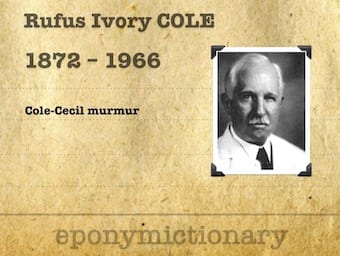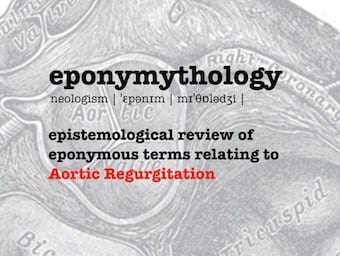
Rufus Cole
Rufus Ivory Cole (1872 - 1966) was an American physician, and the first director of the Rockefellar Institute for Medical Research. Cole-Cecil Murmur

Rufus Ivory Cole (1872 - 1966) was an American physician, and the first director of the Rockefellar Institute for Medical Research. Cole-Cecil Murmur

Chronological review of the clinical signs aortic regurgitation / insufficiency. 31 eponyms proposed by Ashrafian (2005) and Zacek (2018)

Lincoln sign refers to forceful popliteal artery pulsation secondary to aortic regurgitation; exaggerated when the patient sits with legs crossed; and deemed positive if the elevated foot bobs up and down with each systolic contraction.

Friedrich von Müller (1858-1941) was a German physician. Revered as ‘The Great Clinician’. Müller sign in aortic regurgitation (1889).

Thomas Cuming (1798 - 1887) was a North Irish physician renowned for works on aortic incompetence, cancum oris and peripneumonia in children.

Otto Heinrich Enoch Becker (1828-1890) was a German ophthalmologist, eponymous with Becker sign, and Becker test for astigmatism.

Corrigan pulse is the excessive visible arterial pulsations in aortic incompetence. Not to be confused with the palpated 'water-hammer pulse'.

Sir Leonard Erskine Hill (1866 - 1952) was an English physiologist. Remembered for Hill's sign first described in 1909

Raymond de Vieussens (*1641 - 1715) was a French anatomist. He is renowned for his pioneering work on cardiac and nervous system anatomy.

Duroziez-type murmur observed with the patients arm subjected to various temperatures of water and by applying a subdiastolic pressure below the auscultation site, to help differentiate between aortic insufficiency and peripheral vasodilatation.

Arthur Carlton Ernstene (1901-1971) was an American cardiologist. Blumgart-Ernstene murmur (1933)

Herrman Ludwig Blumgart (1895-1977) was an American physician, cardiologist and pioneer of diagnostic nuclear medicine. Blumgart-Ernstene murmur (1933)